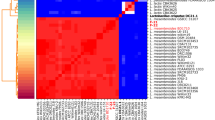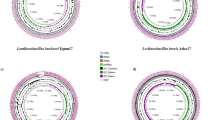Abstract
Lactic acid bacteria (LAB) are fermentative microorganisms and perform different roles in biotechnological processes, mainly in the food and pharmaceutical industries. Among the LAB, Lactobacillus acidophilus is a species that deserves to be highlighted for being used both in prophylaxis and in the treatment of pathologies. Most of the metabolites produced by this species are linked to the inhibition of pathogens. In this study, we utilized a pangenomic and metabolic annotation analysis using Roary and BlastKOALA, ML-based probiotic activity prediction with iProbiotic and whole-genome similarity using ANI to identify strains of L. acidophilus with potential probiotic activity. According to the results in BlastKOALA and iProbiotics, L. acidophilus NCTC 13721 had the greatest potential among the 64 strains tested, both in terms of its ability to be a Lactobacillus spp. probiotic, when in the amount of genes involved in the metabolism of organic acids and quorum sensing. In addition, DSM 20079 proved to be promising for prospecting new probiotic Lactobacillus from BlastKOALA analyses, as they presented similar results in the number of genes involved in the production of lactic acid, acetic acid, hydrogen peroxide, except for quorum sensing where the NCTC 13721 strain had 14 more genes. L. acidophilus NCTC 13721 and L. acidophilus La-5 strains showed greater ability to be Lactobacillus spp. probiotic capacity, showing 84.8% and 51.9% capacity in the iProbiotics tool, respectively. When analyzed in ANI, none of the evaluated strains showed genomic similarity with NCTC 13721. In contrast, the DSM 20079 strain showed genomic similarity with all evaluated strains except NCTC 13721. Furthermore, eight strains with characteristics with approximately 100% genomic similarity to La-5 were listed: S20_1, LA-5, FSI4, APC2845, LA-G80-111, DS1_1A, LA1, and BCRC 14065. Therefore, according to the findings in iProbiotics and BlastKoala, among the 64 strains evaluated, NCTC 13721 is the most promising strain to be used for future in vitro studies.


Similar content being viewed by others
References
FAO/WHO. World Health Organization. Joint FAO/WHO consultation on evaluation of health and nutritional properties of probiotics in food including powder milk with live lactic acid bacteria. Published online 2001. https://www.fao.org/3/a0512e/a0512e.pdf. Accessed 1 Nov 2022
Zheng J, Wittouck S, Salvetti E et al (2020) A taxonomic note on the genus Lactobacillus: description of 23 novel genera, emended description of the genus Lactobacillus Beijerinck 1901, and union of Lactobacillaceae and Leuconostocaceae. Int J Syst Evol Microbiol 70(4):2782–2858. https://doi.org/10.1099/ijsem.0.004107
Goldstein EJC, Tyrrell KL, Citron DM (2015) Lactobacillus species: taxonomic complexity and controversial susceptibilities. Clin Infect Dis 60(suppl_2):S98–S107. https://doi.org/10.1093/cid/civ072
Salvetti E, Torriani S, Felis GE (2012) The genus Lactobacillus: a taxonomic update. Probiotics Antimicrob Proteins 4(4):217–226. https://doi.org/10.1007/s12602-012-9117-8
Reid G, Younes JA, Van der Mei HC, Gloor GB, Knight R, Busscher HJ (2011) Microbiota restoration: natural and supplemented recovery of human microbial communities. Nat Rev Microbiol 9(1). https://doi.org/10.1038/nrmicro2473
Scillato M, Spitale A, Mongelli G et al (2021) Antimicrobial properties of Lactobacillus cell-free supernatants against multidrug-resistant urogenital pathogens. MicrobiologyOpen 10(2). https://doi.org/10.1002/mbo3.1173
Xiao Y, Zhao J, Zhang H, Zhai Q, Chen W (2021) Mining genome traits that determine the different gut colonization potential of Lactobacillus and Bifidobacterium species. Microb Genomics 7(6). https://doi.org/10.1099/mgen.0.000581
Gao H, Li X, Chen X et al (2022) The functional roles of Lactobacillus acidophilus in different physiological and pathological processes. J Microbiol Biotechnol 32(10):1226–1233. https://doi.org/10.4014/jmb.2205.05041
Li W, Zhang Y, Li H et al (2020) Effect of soybean oligopeptide on the growth and metabolism of Lactobacillus acidophilus JCM 1132. RSC Adv 10(28):16737–16748. https://doi.org/10.1039/D0RA01632B
Naidu AS, Bidlack WR, Clemens RA (1999) Probiotic spectra of lactic acid bacteria (LAB). Crit Rev Food Sci Nutr 39(1):13–126. https://doi.org/10.1080/10408699991279187
Salman MK, Abuqwider J, Mauriello G (2023) Anti-quorum sensing activity of probiotics: the mechanism and role in food and gut health. Microorganisms 11(3):793. https://doi.org/10.3390/microorganisms11030793
Zhao X, Yu Z, Ding T (2020) Quorum-sensing regulation of antimicrobial resistance in bacteria. Microorganisms 8(3):425. https://doi.org/10.3390/microorganisms8030425
Liang X, Zhu W, Lv Z, Zou Q (2019) Molecular computing and bioinformatics. Molecules 24(13):2358. https://doi.org/10.3390/molecules24132358
Huang Z, Zhou X, Stanton C et al (2021) Comparative genomics and specific functional characteristics analysis of Lactobacillus acidophilus. Microorganisms 9(9):1992. https://doi.org/10.3390/microorganisms9091992
Altermann E, Russell WM, Azcarate-Peril MA et al (2005) Complete genome sequence of the probiotic lactic acid bacterium Lactobacillus acidophilus NCFM. Proc Natl Acad Sci 102(11):3906–3912. https://doi.org/10.1073/pnas.0409188102
Iartchouk O, Kozyavkin S, Karamychev V, Slesarev A (2015) Complete genome sequence of Lactobacillus acidophilus FSI4, isolated from yogurt. Genome Announc 3(2). https://doi.org/10.1128/genomeA.00166-15
Chung WH, Kang J, Lim MY et al (2018) Complete genome sequence and genomic characterization of Lactobacillus acidophilus LA1 (11869BP). Front Pharmacol 9:311400. https://doi.org/10.3389/fphar.2018.00083
Stahl B, Barrangou R (2013) Complete genome sequence of probiotic strain Lactobacillus acidophilus La-14. Genome Announc 1(3). https://doi.org/10.1128/genomeA.00376-13
Yang X, Wang Y, Huo G (2013) Complete genome sequence of Lactococcus lactis subsp. lactis KLDS4.0325. Genome Announc 1(6). https://doi.org/10.1128/genomeA.00962-13
Yu J, Du X, Wang W et al (2011) Phenotypic and genotypic characteristics of lactic acid bacteria isolated from sour congee in Inner Mongolia of China. J Gen Appl Microbiol 57(4). https://doi.org/10.2323/jgam.57.197
Huang CH, Chen CC, Chiu SH et al (2020) Development of a high-resolution single-nucleotide polymorphism strain-typing assay using whole genome-based analyses for the Lactobacillus acidophilus probiotic strain. Microorganisms 8(9):1445. https://doi.org/10.3390/microorganisms8091445
Palomino MM, Allievi MC, Martin JF et al (2015) Draft genome sequence of the probiotic strain Lactobacillus acidophilus ATCC 4356. Genome Announc 3(1). https://doi.org/10.1128/genomeA.01421-14
(PDF) Infant gut strain persistence is associated with maternal origin, phylogeny, and functional potential including surface adhesion and iron acquisition. ResearchGate. https://doi.org/10.1101/2021.01.26.428340
Gangiredla J, Barnaba TJ, Mammel MK, et al. Fifty-six draft genome sequences of 10 Lactobacillus species from 22 commercial dietary supplements. Genome Announc. Published online June 28, 2018. https://doi.org/10.1128/genomea.00621-18
Sun Z, Harris HMB, McCann A et al (2015) Expanding the biotechnology potential of lactobacilli through comparative genomics of 213 strains and associated genera. Nat Commun 6(1):1–13. https://doi.org/10.1038/ncomms9322
Carpi FM, Coman MM, Silvi S, Picciolini M, Verdenelli MC, Napolioni V (2022) Comprehensive pan-genome analysis of Lactiplantibacillus plantarum complete genomes. J Appl Microbiol 132(1):592–604. https://doi.org/10.1111/jam.15199
Sitto F, Battistuzzi FU (2020) Estimating pangenomes with roary. Hall BG, ed. Mol Biol Evol 37(3):933–939. https://doi.org/10.1093/molbev/msz284
Kanehisa M, Sato Y, Morishima K (2016) BlastKOALA and GhostKOALA: KEGG tools for functional characterization of genome and metagenome sequences. J Mol Biol 428(4):726–731. https://doi.org/10.1016/j.jmb.2015.11.006
Gomez-Fuentes S, Hernández-de la Fuente S, Morales-Ruiz V et al (2021) A novel, sequencing-free strategy for the functional characterization of Taenia solium proteomic fingerprint. Rinaldi G, ed. PLoS Negl Trop Dis 15(2):e0009104. https://doi.org/10.1371/journal.pntd.0009104
Sun Y, Li H, Zheng L et al (2022) iProbiotics: a machine learning platform for rapid identification of probiotic properties from whole-genome primary sequences. Brief Bioinform 23(1):bbab477. https://doi.org/10.1093/bib/bbab477
Jain C, Rodriguez-R LM, Phillippy AM, Konstantinidis KT, Aluru S (2018) High throughput ANI analysis of 90K prokaryotic genomes reveals clear species boundaries. Nat Commun 9(1):5114. https://doi.org/10.1038/s41467-018-07641-9
Ciufo S, Kannan S, Sharma S et al (2018) Using average nucleotide identity to improve taxonomic assignments in prokaryotic genomes at the NCBI. Int J Syst Evol Microbiol 68(7):2386–2392. https://doi.org/10.1099/ijsem.0.002809
Savijoki K, San-Martin-Galindo P, Pitkänen K et al (2022) Food-grade bacteria combat pathogens by blocking AHL-mediated quorum sensing and biofilm formation. Foods 12(1):90. https://doi.org/10.3390/foods12010090
Deng Z, Luo XM, Liu J, Wang H (2020) Quorum sensing, biofilm, and intestinal mucosal barrier: involvement the role of probiotic. Front Cell Infect Microbiol 10:538077. https://doi.org/10.3389/fcimb.2020.538077
Schwendicke F, Korte F, Dörfer CE, Kneist S, Fawzy El-Sayed K, Paris S (2017) Inhibition of Streptococcus mutans growth and biofilm formation by probiotics in vitro. Caries Res 51(2):87–95. https://doi.org/10.1159/000452960
Najarian A, Sharif S, Griffiths MW (2019) Evaluation of protective effect of Lactobacillus acidophilus La-5 on toxicity and colonization of Clostridium difficile in human epithelial cells in vitro. Anaerobe 55:142–151. https://doi.org/10.1016/j.anaerobe.2018.12.004
Zambori C, Morvay AA, Sala C et al (2016) Antimicrobial effect of probiotics on bacterial species from dental plaque. J Infect Dev Ctries 10(3):214–221. https://doi.org/10.3855/jidc.6800
Fox MJ, Ahuja KDK, Robertson IK, Ball MJ, Eri RD (2015) Can probiotic yogurt prevent diarrhoea in children on antibiotics? A double-blind, randomised, placebo-controlled study. BMJ Open 5(1):e006474. https://doi.org/10.1136/bmjopen-2014-006474
Litus O, Derkach N, Litus V, Bisyuk Y, Lytvynenko B (2019) Efficacy of probiotic therapy on atopic dermatitis in adults depends on the C-159T polymorphism of the CD14 receptor gene - a pilot study. Open Access Maced J Med Sci 7(7):1053–1058. https://doi.org/10.3889/oamjms.2019.242
Tonucci LB, Olbrich Dos Santos KM, Licursi de Oliveira L, Rocha Ribeiro SM, Duarte Martino HS (2017) Clinical application of probiotics in type 2 diabetes mellitus: a randomized, double-blind, placebo-controlled study. Clin Nutr Edinb Scotl 36(1):85–92. https://doi.org/10.1016/j.clnu.2015.11.011
Tsilika M, Thoma G, Aidoni Z et al (2022) A four-probiotic preparation for ventilator-associated pneumonia in multi-trauma patients: results of a randomized clinical trial. Int J Antimicrob Agents 59(1):106471. https://doi.org/10.1016/j.ijantimicag.2021.106471
Tachedjian G, Aldunate M, Bradshaw CS, Cone RA (2017) The role of lactic acid production by probiotic Lactobacillus species in vaginal health. Res Microbiol 168(9-10):782–792. https://doi.org/10.1016/j.resmic.2017.04.001
Hernández-Aquino S, Miranda-Romero LA, Fujikawa H, Maldonado-Simán EDJ, Alarcón-Zuñiga B (2019) Antibacterial activity of lactic acid bacteria to improve shelf life of raw meat. Biocontrol Sci 24(4):185–192. https://doi.org/10.4265/bio.24.185
Stanojević-Nikolić S, Dimić G, Mojović L, Pejin J, Djukić-Vuković A, Kocić-Tanackov S (2016) Antimicrobial activity of lactic acid against pathogen and spoilage microorganisms: antimicrobial activity of lactic acid. J Food Process Preserv 40(5):990–998. https://doi.org/10.1111/jfpp.12679
Watanabe T, Nishio H, Tanigawa T et al (2009) Probiotic Lactobacillus casei strain Shirota prevents indomethacin-induced small intestinal injury: involvement of lactic acid. Am J Physiol-Gastrointest Liver Physiol 297(3):G506–G513. https://doi.org/10.1152/ajpgi.90553.2008
Markowiak-Kopeć P, Śliżewska K (2020) The effect of probiotics on the production of short-chain fatty acids by human intestinal microbiome. Nutrients 12(4):1107. https://doi.org/10.3390/nu12041107
Rajab S, Tabandeh F, Shahraky MK, Alahyaribeik S (2020) The effect of lactobacillus cell size on its probiotic characteristics. Anaerobe 62:102103. https://doi.org/10.1016/j.anaerobe.2019.102103
Bull M, Plummer S, Marchesi J, Mahenthiralingam E (2013) The life history of Lactobacillus acidophilus as a probiotic: a tale of revisionary taxonomy, misidentification and commercial success. FEMS Microbiol Lett 349(2):77–87. https://doi.org/10.1111/1574-6968.12293
Amann RI, Ludwig W, Schleifer KH (1995) Phylogenetic identification and in situ detection of individual microbial cells without cultivation. Microbiol Rev 59(1):143–169
Acknowledgements
We are grateful to Fábio Pereira Leivas Leite, Daniela Peres Martinez, and Carlos James Scaini for the contribution in the manuscript revision and the Omixlab (Bioinformatics Laboratory of the Federal University of Pelotas) team for all the analysis support. We also thank CAPES and the Post-Graduate Program in Health Sciences of Federal University of Rio Grande for the scholarship granted, which made this work possible.
Author information
Authors and Affiliations
Corresponding author
Ethics declarations
Competing interests
The authors declare no competing interests.
Additional information
Publisher’s Note
Springer Nature remains neutral with regard to jurisdictional claims in published maps and institutional affiliations.
Responsible Editor: Gisele Monteiro
Supplementary information
ESM 1
(XLSX 72 kb)
Rights and permissions
Springer Nature or its licensor (e.g. a society or other partner) holds exclusive rights to this article under a publishing agreement with the author(s) or other rightsholder(s); author self-archiving of the accepted manuscript version of this article is solely governed by the terms of such publishing agreement and applicable law.
About this article
Cite this article
Dias, R.S., Kremer, F.S. & da Costa de Avila, L.F. In silico prospection of Lactobacillus acidophilus strains with potential probiotic activity. Braz J Microbiol 54, 2733–2743 (2023). https://doi.org/10.1007/s42770-023-01139-3
Received:
Accepted:
Published:
Issue Date:
DOI: https://doi.org/10.1007/s42770-023-01139-3




